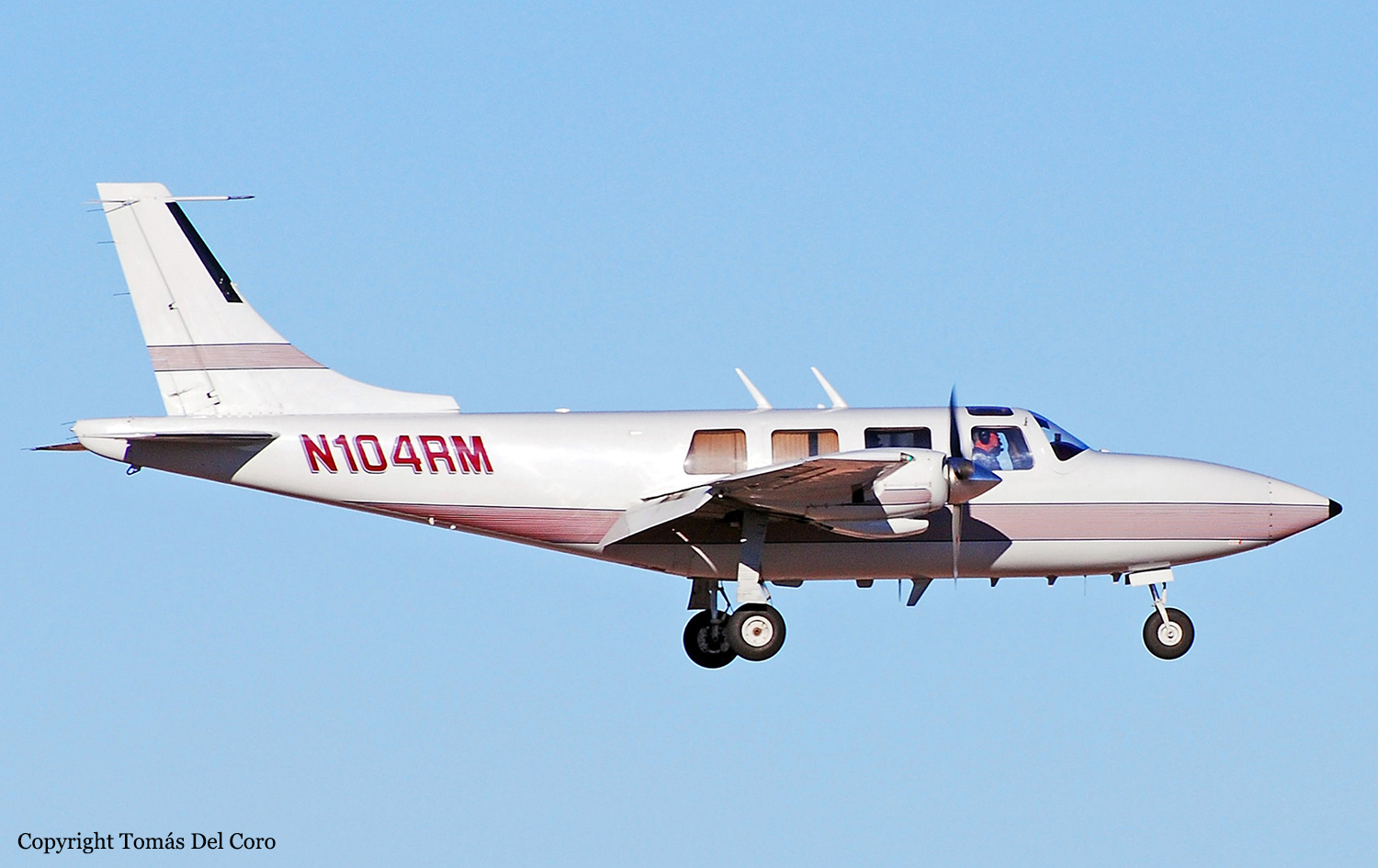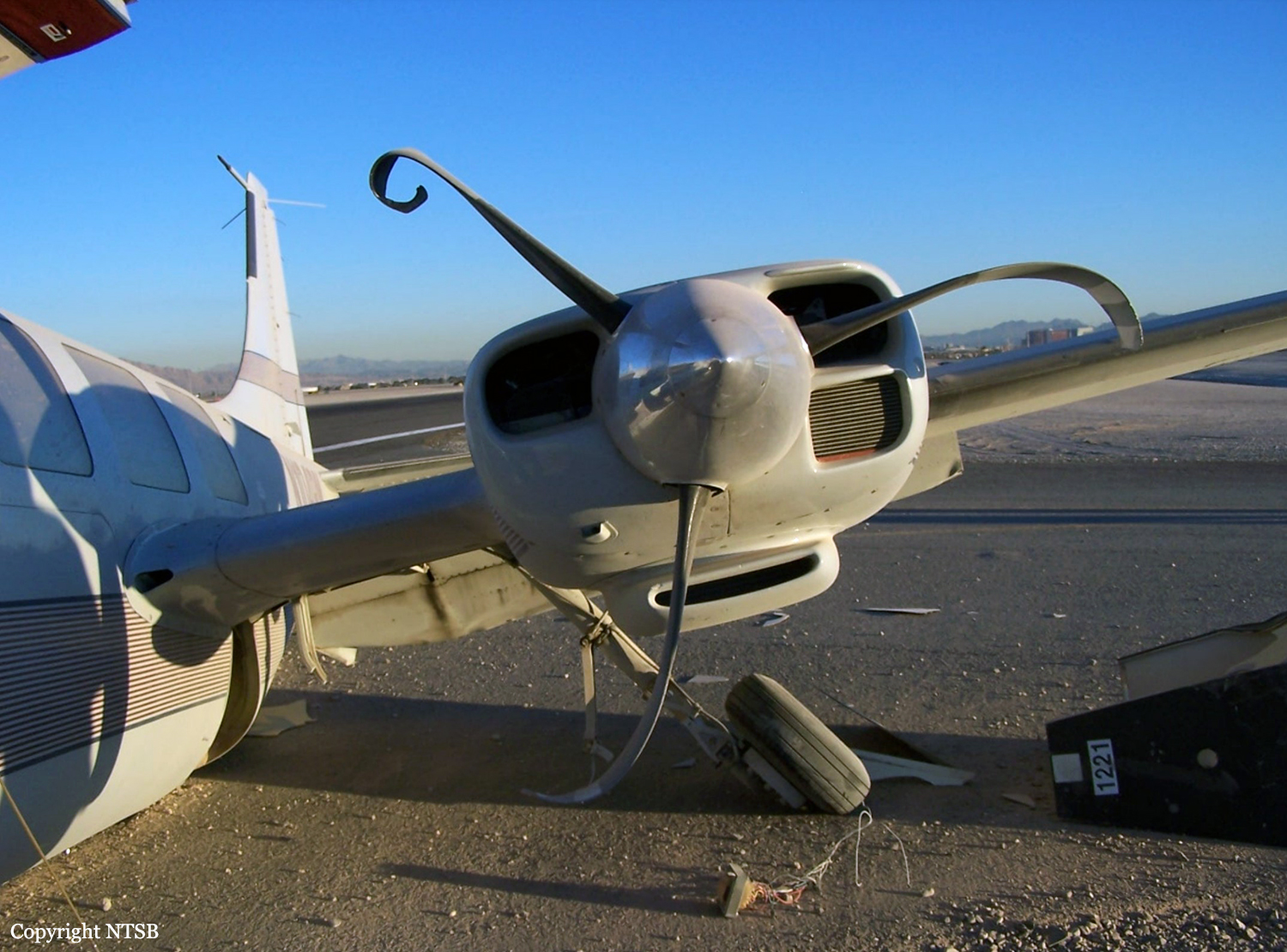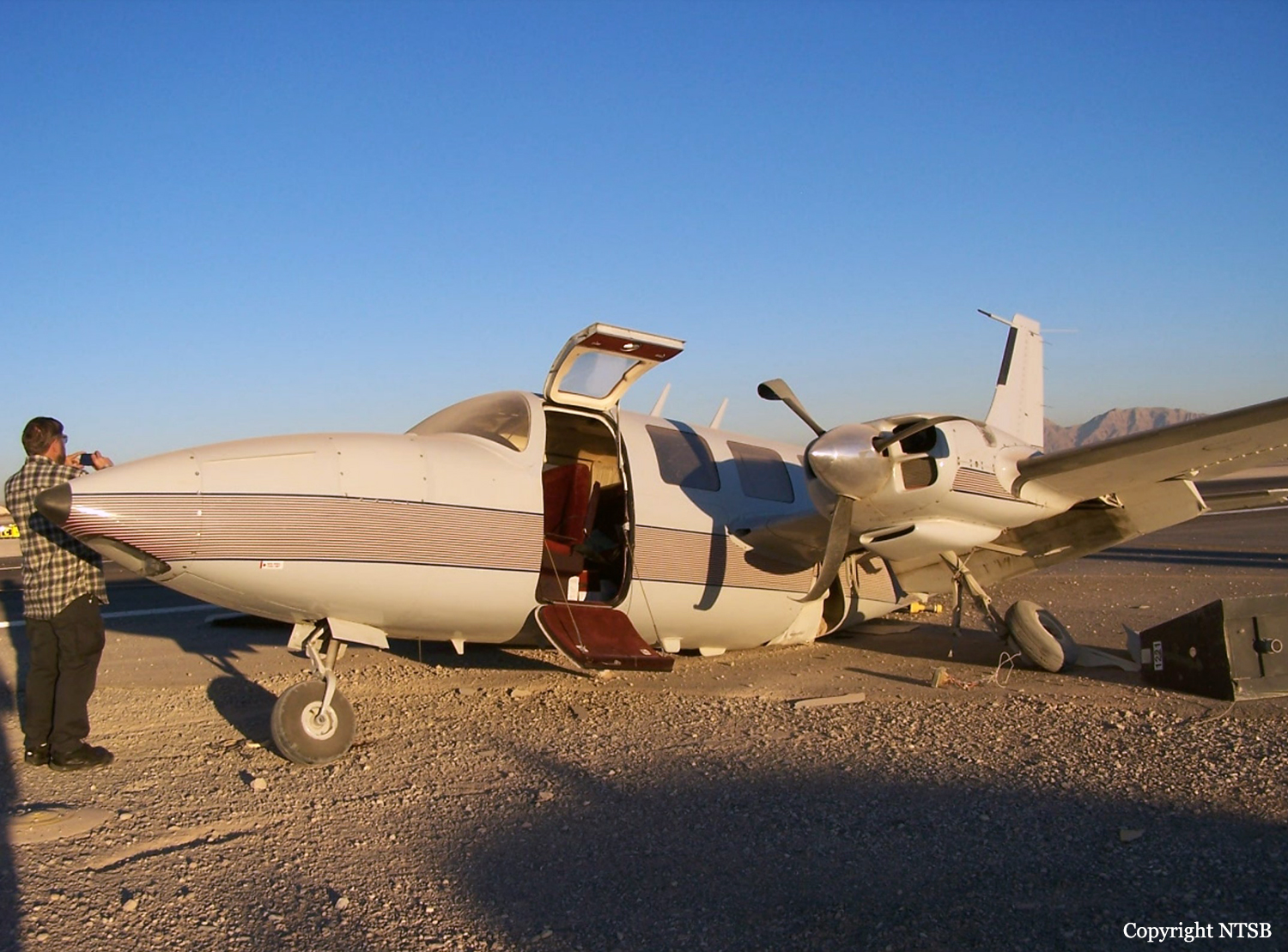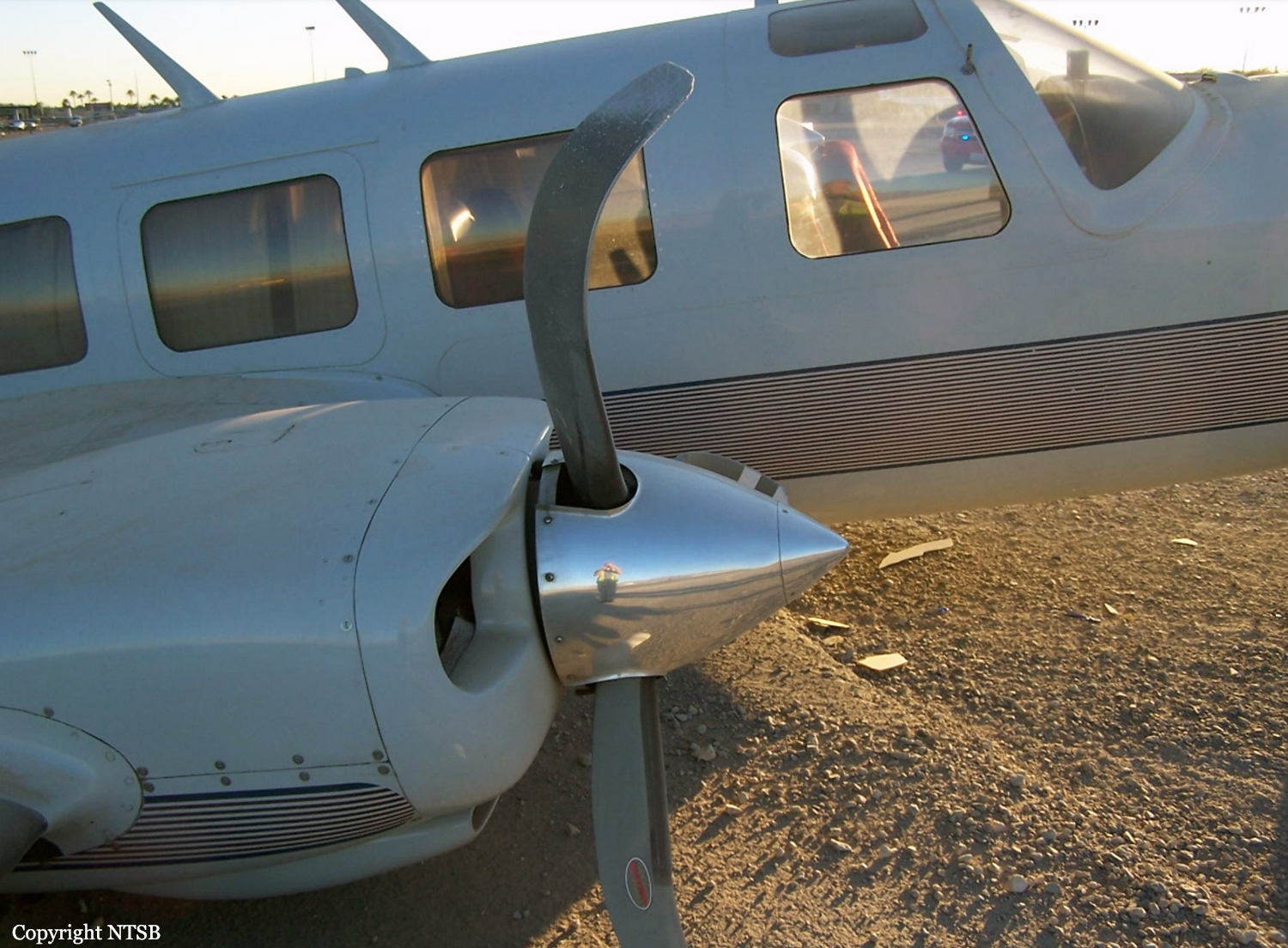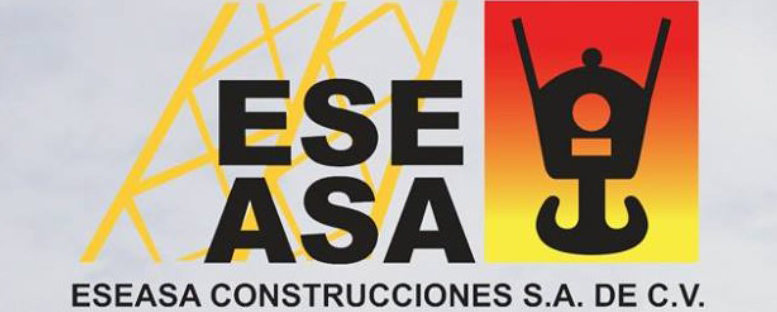Country
code
NV
Crash of a Rockwell Sabreliner 65 in Las Vegas
Date & Time:
Jul 5, 2013 at 1845 LT
Registration:
XB-RSC
Survivors:
Yes
Schedule:
Brownsville – Las Vegas
MSN:
465-55
YOM:
1981
Crew on board:
2
Crew fatalities:
Pax on board:
4
Pax fatalities:
Other fatalities:
Total fatalities:
0
Captain / Total hours on type:
2100.00
Copilot / Total hours on type:
788
Aircraft flight hours:
9940
Circumstances:
The pilots reported that, during the approach, the main hydraulic system lost pressure. They selected the auxiliary hydraulic system "on," continued the approach, and extended the landing gear using the emergency landing gear extension procedures. During the landing roll, about two-thirds down the runway, the pilots noticed that the brakes were not working normally and then turned onto a taxiway to clear the runway. The captain reported that, once on the taxiway, he was unable to stop or steer the airplane as it proceeded across a parallel runway and into an adjacent field where it subsequently struck a metal beam. A postaccident examination of the airplane revealed brake system continuity with the cockpit controls. The tires, brake assemblies, and brake pads were intact and undamaged. The hydraulic lines from the hydraulic pump to the wheel brakes were intact. No hydraulic fluid was observed leaking on the exterior or interior portions of the airplane. The hydraulic fluid reservoir was found about 1/4 full. Further, testing of the two hydraulic pumps revealed that they were both functional, and no mechanical failures or anomalies that would have precluded normal operation were noted. The airplane's hydraulic system failure emergency procedures state that, if hydraulic pressure is lost, the electrically driven hydraulic pump should be reset and that, if the hydraulic pressure was not restored, that the primary hydraulic system should be disengaged and the landing gear should be lowered using the emergency landing gear extension procedures. After the gear is extended, the auxiliary hydraulic system should be selected "on" for landing. However, the pilots stated that they did not attempt to reset the electric hydraulic pump and that they performed the emergency landing gear extension procedures with the auxiliary hydraulic pump engaged. It is likely that the pilots' failure to select the auxiliary hydraulic system "off" before extending the landing gear caused the hydraulic pressure in the auxiliary system to dissipate, which left only the emergency brake accumulator available for braking during the landing. The number of emergency brake applications that can be made by the pilots depends on the accumulator charge, which may be depleted in a very short time. The airplane's emergency braking procedures state that, as soon as the airplane is safely stopped, the pilots should request towing assistance. However, the pilots did not stop the airplane on the runway despite having about 3,900 ft of runway remaining; instead, they turned off the runway at an intersection, which resulted in a loss of directional control.
Probable cause:
The pilots' failure to follow the airplane manufacturer's emergency procedures for a hydraulic system failure and emergency braking, which resulted in the loss of braking action upon landing and the subsequent loss of directional control while turning off the runway. Contributing to the accident was the loss of hydraulic pressure for reasons that could not be determined because postaccident testing and examination of the hydraulic system revealed no mechanical failures or anomalies that would have precluded normal operation.
Final Report:
Crash of a Piper PA-60 Aerostar (Ted Smith 602P) in North Las Vegas
Date & Time:
Jan 2, 2013 at 1515 LT
Registration:
N3AG
Survivors:
Yes
Schedule:
North Las Vegas - North Las Vegas
MSN:
60-8365-018
YOM:
1983
Crew on board:
2
Crew fatalities:
Pax on board:
0
Pax fatalities:
Other fatalities:
Total fatalities:
0
Captain / Total hours on type:
1700.00
Copilot / Total hours on type:
60
Aircraft flight hours:
3259
Circumstances:
The pilot receiving instruction conducted three full-stop landings without incident. After the fourth takeoff, the flight instructor simulated a prearranged left engine failure about 600 ft above ground level (agl). The pilot followed emergency procedures, used the checklist, and prepared to land. The pilot reported that, when the airplane was about 50 to 100 ft agl on final approach, he thought that it was a little too high, so he chose to initiate a go-around. He moved the throttle levers full forward, but neither engine responded. The flight instructor pushed the airplane's nose down, and the pilot continued the approach. On touchdown, the right main and nose landing gear collapsed. A postimpact fire ensued, which consumed most of the airplane. Postaccident examination of the landing gear revealed that it collapsed due to bending overload consistent with a hard landing. The reason for the failure of both engines to respond to power inputs could not be determined because of the postcrash fire damage.
Probable cause:
The pilot's failure to maintain an adequate descent rate while on final approach, which resulted in a hard landing and landing gear collapse due to overload following the failure of both engines to respond to power inputs during an attempted go-around for reasons that could not be determined due to postcrash fire damage.
Final Report:
Crash of a Piper PA-31T1 Cheyenne I near Ely: 2 killed
Date & Time:
Dec 15, 2012 at 1000 LT
Registration:
N93CN
Survivors:
No
Schedule:
Mesa - Portland
MSN:
31-8004029
YOM:
1980
Crew on board:
1
Crew fatalities:
Pax on board:
1
Pax fatalities:
Other fatalities:
Total fatalities:
2
Aircraft flight hours:
5725
Circumstances:
The private pilot and passenger departed on the 875-nautical-mile cross-country flight and leveled off at a cruise altitude of 24,000 feet mean seal level, which, based on the radar data, was accomplished with the use of the autopilot. About 1 hour 40 minutes after departure, the pilot contacted air traffic control personnel to request that he would “like to leave frequency for a couple of minutes.” No further radio transmissions were made. About 20 seconds after the last transmission, the airplane banked to the right, continued in a spiral while rapidly descending, and subsequently broke apart. At no time during the flight did the pilot indicate that he was experiencing difficulty or request assistance. Just prior to departing from the flight path, the pilot made an entry of the engine parameters in a flight log, which appeared to be consistent with his other entries indicating the airplane was not experiencing any difficulties. Portions of the wings, along with the horizontal stabilizers and elevators, separated during the breakup sequence. Analysis of the fracture surfaces, along with the debris field distribution and radar data, revealed that the rapid descent resulted in an exceedance of the design stress limits of the airplane and led to an in-flight structural failure. The airplane sustained extensive damage after ground impact, and examination of the engine components and surviving primary airframe components did not reveal any mechanical malfunctions or failures that would have precluded normal operation. The airplane was flying on a flight path that the pilot was familiar with over largely unpopulated hilly terrain at the time of the upset. The clouds were well below his cruising altitude, giving the pilot reliable external visual cues should the airplane have experienced a failure of either the flight instruments or autopilot. Further, no turbulence was reported in the area. The airplane was equipped with a supplemental oxygen system, which the pilot likely had his mask plugged into and available in the unstowed position behind his seat; the passenger’s mask was stowed under her seat. The airplane’s autopilot could be disengaged by the pilot by depressing the appropriate mode switch, pushing the autopilot disengage switch on the control wheel, or turning off the autopilot switch on the control head. All autopilot servos were also equipped with a clutch mechanism that allowed the servo to be manually overridden by the pilot at any time. It is likely that the reason the pilot requested to “leave the frequency” was to leave his seat and attend to something in the airplane. While leaving his seat, it is plausible he inadvertently disconnected the autopilot and was unable to recover by the time he realized the deviation had occurred.
Probable cause:
The pilot’s failure to regain airplane control following a sudden rapid descent during cruise flight, which resulted in an exceedance of the design stress limits of the aircraft and led to an in-flight structural failure.
Final Report:

Crash of a Piper PA-61 Aerostar (Ted Smith 601P) in North Las Vegas
Date & Time:
Jan 5, 2012 at 1539 LT
Registration:
N104RM
Survivors:
Yes
Schedule:
North Las Vegas - North Las Vegas
MSN:
61-0756-8063375
YOM:
1980
Crew on board:
1
Crew fatalities:
Pax on board:
0
Pax fatalities:
Other fatalities:
Total fatalities:
0
Captain / Total hours on type:
1700.00
Aircraft flight hours:
4480
Circumstances:
The pilot reported that, immediately after touchdown, the airplane began “wavering” and moments later veered to the left. He attempted to regain directional control with the application of “full right rudder” and the airplane subsequently departed the right side of the runway. A witness reported that the airplane’s touchdown was “firm” but not abnormal. As the airplane approached the left side of the runway, it yawed right and skidded down the runway while facing right. As the airplane began moving to the right side of the runway, the witness heard the right engine increase to near full power. The airplane spun to the left, coming to rest facing the opposite direction from its approach to landing. Another witness reported seeing the propellers contact the ground. The pilot attributed the loss of directional control to a main landing gear malfunction. Post accident examination of the airplane revealed that the left propeller assembly was feathered and that the right propeller blades were bent forward, indicative of the right engine impacting terrain under high power. Both throttle levers were found in the aft/closed position, and both propeller control levers were in the full-forward position. The propeller control levers exhibited little friction and could be moved with pressure from one finger. The evidence suggested that the pilot inadvertently feathered the left propeller assembly during the accident sequence. The pilot did not report any pre accident malfunctions or failures with the airplane’s engines or propeller assemblies that would have precluded normal operation.
Probable cause:
The pilot's failure to maintain directional control of the airplane during the landing roll.
Final Report:
